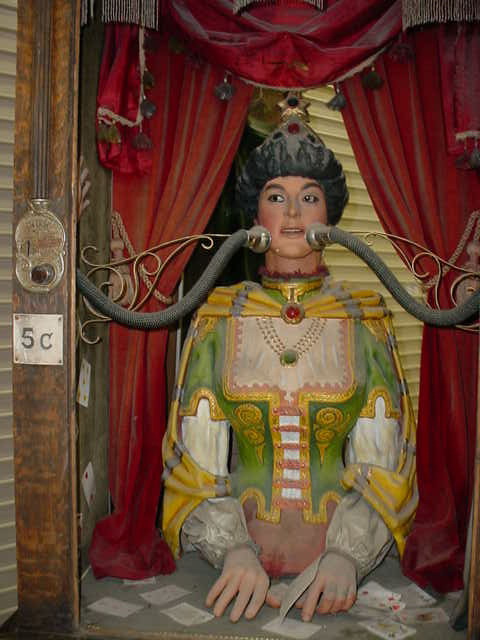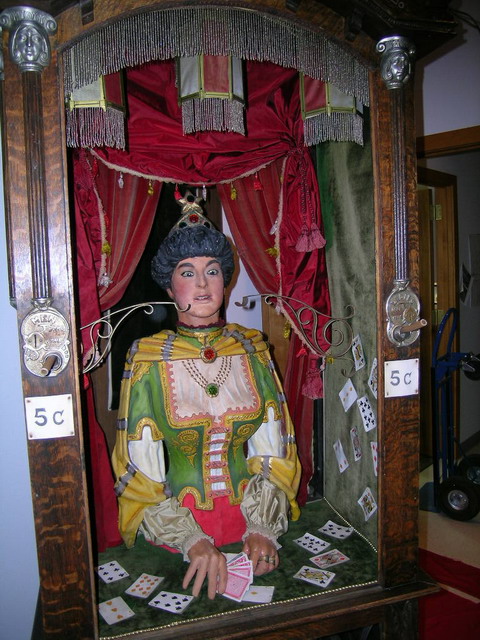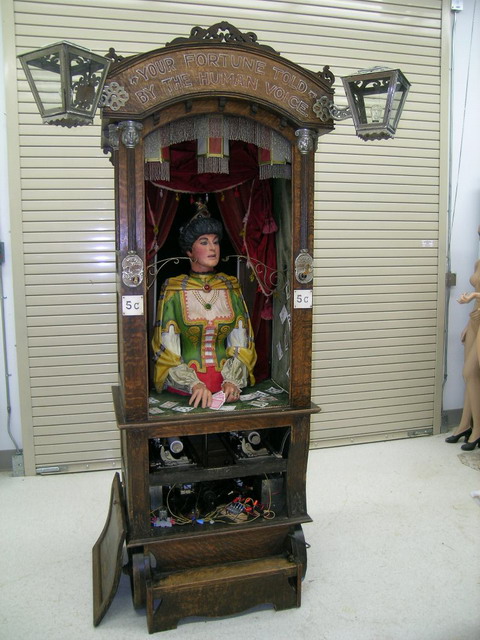
Abstract
(see illustrations below)
MILLS NOVELTY COMPANY GYPSY FORTUNE TELLING MACHINE
VC 2000.02.59
To:
State of Montana
Montana Heritage Commission
McFarland Curatorial Center
Virginia City, Montana
January 11, 2007
Introduction:
The Mills Verbal Fortune Teller Machine constructed (1906 or1907) by the Mills Novelty Company (MNCo.) is a part of the massive eclectic Bovey historical collection of properties and objects. Mr. Bovey’s (former state senator and heir to the General Mills fortune) estate was purchased in by the State of Montana in 1997. This fortune telling machine was in use by visitors in Virginia City, MT up to the early 1970’s and then only displayed to the public until 1999. After which, the machine was placed in collections storage. The conservation treatment began in September 2004 and concluded in June 2006.
The treatment, though complex and multi-disciplined, began as a challenge and concluded with a sense of accomplishment. The first issues addressed were of functionality, to put a nickel ‘in’ and yield an audible fortune ‘out’. Once achieved, the decorative and whimsical elements required cleaning, stabilization, or element replacement. Loss compensation offered the most creative aspect of being in-treatment. The below and itemized section is written to be concise. The Daily Treatment Report does offer a more detailed accounting of treatment.
Treatment objective:
The treatment objective is to render this machine in working order with the overall intervention predicated on the most current philosophies guiding aged objects care found in both the museum and in the discriminating market place. This involves prizing stable original fabric and a standard of minimal intervention. In effect, returning the machine to as historically minimally compromised configuration.
TREATMENT
At the McFarland Curatorial Center, Virginia City, MT, the Gypsy was disassembled and packed for shipment to the conservator’s bench in Hall, MT.
Once on the bench and dismantled further, individual components received closer attention. While registering components and elements to “home” locations, condition appraisals were ongoing.
To facilitate study and treatment, all of the electromechanical parts were removed from the case platform and installed onto a proportionately sized external jig platform for ease of access. After studying the movements and interrelated linkages, speculation began on stabilization for electromechanical components, component elements, and options for any necessary loss compensation; as the search for an identical mechanical movement found no positive results.
Also, fastened to the jig, the animatronics’ were studied. Treatment and interrelated tuning was performed.
The missing component functions, lead design, and fabrication needs were determined. Using new iron, bearings, solenoids, and fuses currently manufactured; the necessary replacement in-fills for function became successful. When available, original fasteners were returned to their original holes. New fasteners are visually apparent; yet not observable as the machine stands ready. The overall appearance is in keeping with the Gypsy’s age.
Treatment proceeded to a cadence of “performance and function” thereby keeping parameters of scope and degree related to treatment contract criteria.
The following information itemizing and describing this conservation treatment is according to components. The order of entries within this document does not reflect treatment sequence. The methodology for sequential activity seemed to take on own inertia for the objects dignity, grace and permanence.
A simplified explanation of how the gypsy works is as follows:
1. Pick up the female or male sound tube/horn assemble, insert a nickel and a fortune is audible.
2. Inside the machine, the nickel travels down a track where the coin moves a lever that closes a switch which creates voltage simultaneously at the motor and one solenoid.
3. The motor begins to turn the belt-driven shaft and the solenoid pulls the shaft to engage to correct sheave which in turn engages the selected gendered gramophone, directs the head to turn, starts the mouth moving, and the eyes move sporadically left to right and up and down.
4. Attached to the gramophone is a brass saw tooth installed by MNCo, which starts and stops the gramophone mandrel (holding the cylinder record) revolutions.
5. The gramophone’s reproducer produces the mechanical vibrations for audibility. This sound then travels through a “rubber” hose and out a hand-held horn.
To understand how these components truly work together, one need only to insert a nickel. The machine does work and the conservation product supports the maker’s intent. As for fortune predictability, one person’s future is unique and seldom truly understood by its seeker.

Before Conservation

Restoration Complete

Full View